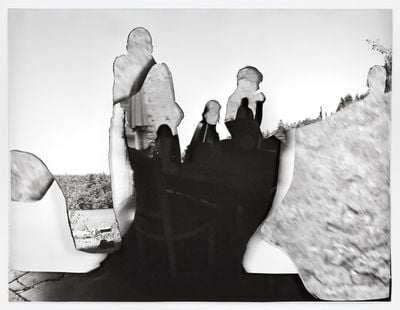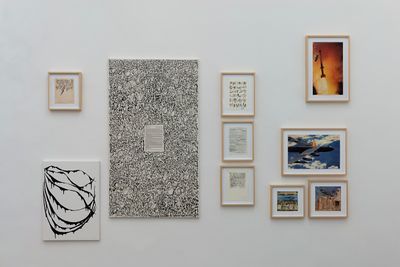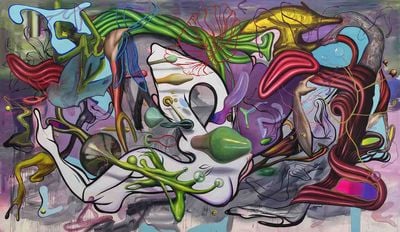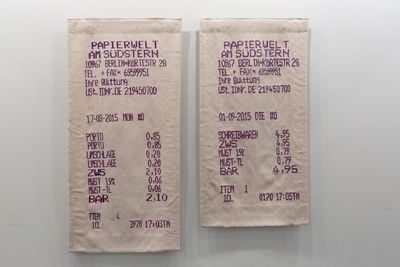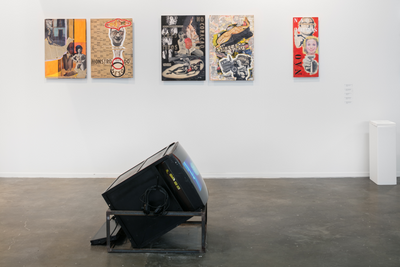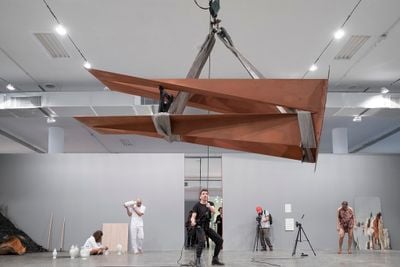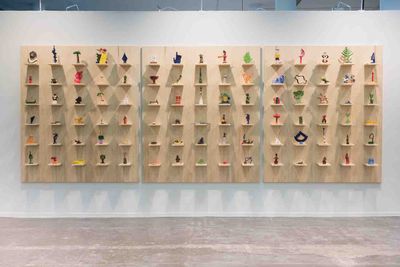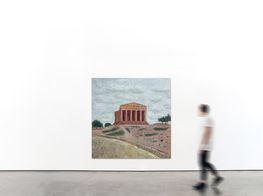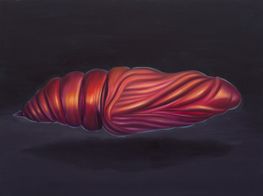Commentary and Process: SP-Arte 2018
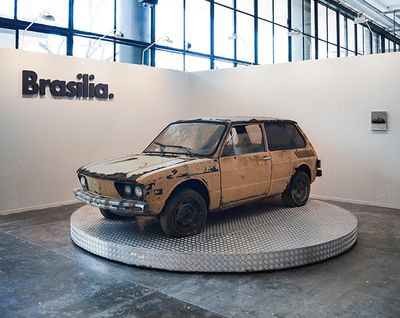
Bruno Faria, Brasília (2018). Installation view: Galeria Periscópio, SP-Arte, São Paulo (11–15 April 2018). Courtesy Galeria Periscópio.
Throughout SP-Arte 2018, an expressive array of artwork communicated healthy questions surrounding art and its relation to the world—from within the problematic processes and systems that sustain it.
São Paulo's 14th SP-Arte (11–15 April 2018) extended far beyond the Oscar Niemeyer-designed Bienal Pavilion, which housed more than 160 exhibitors for the event this year, filling the city with exhibitions, talks, performances, studio visits and visits to private collections. As in previous years, 'Gallery Night' kicked off the week with galleries staying open late on the evenings of 9 and 10 April, prior to SP-Arte's 11 April preview. Among the exhibitions were the inaugural shows of two new gallery outposts in São Paulo: SIM Galeria and Simões de Assis Galeria de Arte, both headquartered in the city of Curitiba.
At SIM, Zonas de Gatilho (7 April–19 May 2018) showcased Franco-Brazilian artist Julia Kater's large-scale, layered cut-out photographs, including Brasey (2018) and Malena (2018), which explore the tensions between presence and absence in relation to the passing of time. A series of intriguing small, black oil paintings from the series 'Carbon' (2018) made by recreating children's drawings using carbon paper, expose the cognitive and unconscious mechanisms at play during a child's formative years. Simões de Assis exhibited an exquisite display of around 40 abstract-geometric works made between the mid-1940s and early-2000s by Uruguayan artist Carmelo Arden Quin (deceased in 2010 at the age of 97), a founding member of the Madí movement who has yet to see the international art market recognition he deserves.
Another panoramic survey of a prolific South American artist was staged at Galeria Nara Roesler: León Ferrari's For a World with No Hell (11 April–30 May 2018) curated by Lisette Lagnado. Ferrari, who died in 2013 at the age of 93, was awarded a Golden Lion at the Venice Biennale in 2007. This exhibition covers almost half a century of this artist's vast oeuvre—artwork that predominantly explores representations of power within society.
Casa Triângulo chose to show Rodolpho Parigi, a Brazilian artist in his early 40s and the newest member of this gallery's roster. Parigi's painstakingly crafted paintings and drawings collate disparate visual references from the history of art, queer and pop cultures, to anatomical and botanical studies, resulting in vertiginous images such as the explosively colourful large-scale oil on canvas painting La danse (2018), and Sorbet de Chignon (2018)—an alluring monochromatic red drawing in which a styled clump of braided hair echoes a vital organ.
Casa Triângulo's selection for its booth in the 'Main' sector of SP-Arte was significantly more sober by comparison, with numerous artworks in different shades of grey, white and black, such as a painting by Sandra Cinto and concrete, paper and metal free-standing sculptures by Lucas Simões.
In fact, there was barely any trace of the over-the-top large-scale installations seen in previous editions of the fair. Located at one of the entrances to the Main sector was neugerriemschneider, whose pristine booth predominantly featured works made in reflective materials and/or cold hues, including Rirkrit Tiravanija's untitled 2013 (no no america) (2013), a reflective surface with 'No No America' inscribed on it.
Political commentary continued throughout SP-Arte, with references to finance offering at once a self-reflexive critique of the fair, and a reflection on the state of economic affairs beyond its corridors. At Mexico City's kurimanzutto, Gabriel Kuri's Untitled (Papierwelt) (2017) comprised two hand-woven wool tapestries that reproduced over-sized expense bills, while Gabriel Orozco subverted the primary symbol of commerce in Untitled (bill 7) (2016), by making geometric interventions in green, red and gold on a one peso bill. Damián Ortega also made use of geometry in a framed-yet-unfinished embroidery of concentric circles in tonal greys to raise questions surrounding the process of art-making and retailing today (Patrón rítmico-Color test 1, 2014).
Other artworks celebrated lengthy artisanal processes as a way of resisting the accelerated pace of 21st century life. Alongside Stephan Balkenhol's masterfully hand-carved wood reliefs and sculptures of human figures at Stephen Friedman Gallery, for example, were Channing Hansen's knitted paintings including 18 Manifold (2018), which consists of colourful yarns stretched across visible wooden frames to create abstracted patterns. Channing's embrace of craft and technology (he hand spins and dyes the yarn and uses an algorithm to work on the layout) embraces the virtues of harmonious encounters between seemingly disparate processes and considers how new operating models can update established practices.
Artwork based on language was another recurring thread in the pavilion and outside it; it was the subject of a beautiful group show entitled A Poesia e as Artes Visuais (Poetry and the Visual Arts) (10 April–30 May 2018) at Galeria Superfície's recently refurbished building, which gathered works by 41 inter-generational artists and collectives such as Mira Schendel, Leonilson, and Falves Silva, under the premise of showing the profusion of possibilities in which words and letters fuse with aesthetic principals in visual art to create new lines of questioning and communication. Back in the Pavilion at Galeria Leme, Jaime Lauriano's series of traditional Portuguese paving mosaics 'Pedras Portuguesas (Portuguese Stones)' (2017), contains the names of countries in Africa such as Costa da Mina, from which slave-bearing vessels left for Brazil. The layering of these traditional paving mosaics by slaves in Portuguese colonies was habitual, and they line the streets of Brazilian cities to this day.
SP-Arte's 'Repertoire' sector, curated by Jacopo Crivelli Visconti, featured 13 galleries showing art that was created in the years running up to and including the 1980s. On view were little-known collages made from appropriated 1960s popular imagery by Brazilian artist Victor Gherhard, exhibited by Galeria Jaqueline Martins. In DC60, from the series 'Drama Carioca' (1966), a man's grinning face pasted onto a newspaper background is surrounded by the words 'sex', hand-written several times over, as the man's glasses reflect images of nude female bodies and a cut-out of two girls floats above his forehead. With a headline reading 'Sex Monster', that these collages are some 60 years old, they are unfortunately still relevant.
Since its foundation in 2011, Galeria Jaqueline Martins has run a programme entitled 'Affairs', which aims to research, catalogue and re-present work by artists of the 1970s and 80s that has been extensively neglected over the last decades—including the legacy of Gerhard.
Found images were also used by Arnaldo de Melo in paintings exhibited by Sé Galeria, also participating in the Repertoire sector. Some of Melo's work dates from the mid-1980s, when he was living in New York and couldn't afford to buy paper or canvases and resorted to painting cartoon-like figures. Inspired by the American street art he was exposed to, Melo would paint onto exhibition brochures and invitations he had to other artists' shows. 30 years later, these paintings offer insight into how the competitive nature of the art market impacts art-making.
Brazilian art collector Pedro Barbosa, who was a collector-in-residence at Delfina Foundation in London in 2017, is a great believer in the importance of ephemera (exhibition brochures, invitations, catalogues, memorabilia, and so on) and the central role it plays in preserving and shaping the stories and histories related to art. As such, Barbosa redirected his efforts a few years ago from acquiring artwork to retrieving these types of materials and organising an expressive archive, a small section of which, focused on dance and performance, was presented at the exhibition Reté (9–30 April 2018), displayed in a private apartment and curated by Camilo Godoy.
On 13 April, the collector participated in a panel discussion with Aaron Cezar, Director of Delfina Foundation and Akio Aoki, director of Galeria Vermelho, entitled 'Collecting and new practices'. During the discussion Barbosa highlighted the essential role these undervalued objects play in the art world and how he has come to believe they might even be more important than the artwork itself.
SP-Arte's official 'Performance' programme, curated by Paula Garcia, brought together five long-duration performances that occurred simultaneously in an enclosed space in the pavilion. Although their closeness meant that performances seemed to fuse together, Paul Setúbal's struggle to maintain a large, 250-kilo sculpture by Franz Weissmann suspended in the air using his own body weight in Compensação por Excesso (Compensation by Excess) (2018), stood out. It was a visceral and pointed statement about the relationship between the historic and commercial value and weight of an artwork versus the role of a person in the art system.
The 'Design' sector on the third floor was a universe unto itself, where 33 exhibitors displayed vintage and contemporary furniture and objects. For the first time at SP-Arte, independent designers showed their work alongside antiques dealers and highly-esteemed contemporary brands, such as FirmaCasa and ,ovo. The former exhibited the 'Astral' series of floor lamps, designed by Candida Tabet, a limited edition made from appropriated antique glass lamp shades piled to create a totemic structure reminiscent of architectural balustrades.
,ovo showed a beautiful selection of wooden side tables from the 'Xeque' series that were made to resemble abstracted chess pieces and were displayed on a low platform on the ground in order to heighten their sculptural qualities. Independent designer Noemi Saga's hand-crafted wood dining table, Tepacê, looks like a fish spine inspired by 1970s Structural Expressionism.
'Solo', a sector of SP-Arte curated by Luiza Teixeira de Freitas for the third time, was dedicated to 16 galleries exhibiting one artist each. Pedro Wirz's numerous colourful glazed ceramic sculptures comprising Novos Amigos (New Friends) (2013–2018), brought to SP-Arte by South African gallery Blank Projects, were co-created by the artist and participants of a series of lectures in Europe and Brazil led by Wirz, in which he recounted memories of his home town, Pindamonhangaba in Brazil. Wirz, who lives and works in Switzerland, requested the audience to imagine possible sculptures he could make from the experiences he shared, touching on issues surrounding the formation of identity in an ever more globalised world.
At Spain's espaivisor, Mladen Stilinović's Artist at Work (1978)—a group of eight unlimited edition photographs depicting the artist sleeping—offered a commentary on the pervasive nature of artistic productivity and its relation to the final art work within the space of the market.
Throughout SP-Arte 2018, an expressive array of works communicated healthy questions surrounding the problematic processes and systems that sustain the art world and its relation to the world at large. Encapsulating this constellation of objects and concepts tackling social, political and artistic concerns with critical insight was Bruno Faria's Brasília (2018), which took centre stage at Galeria Periscópio's booth: presented on a rotating display platform was a decrepit vintage Volkswagen Brasília car that was launched to celebrate the inauguration of Brazil's homonymous federal capital. This utopian, modernist city—solely designed to become the seat of the government—was built from scratch in the 1950s in the Brazilian highlands, and the middle of nowhere, under President Juscelino Kubitschek's slogan of '50 years of progress in 5'. With Oscar Niemeyer as the city's architect and Lucio Costa its urban planner, the unfinished site was inaugurated in 1960, and it took a further 10 years to transfer all federal entities there from Rio, the former capital. In 1987, Brasilia became a world heritage site, and today has been described as an 'office campus for a government'.
In 2018, when presidential elections will be held in Brazil amidst deep-rooted political scandals, Faria's car stands as an embodiment of the self-serving structures that are withering; not only in the very city that President Kubitschek hoped would become the country's emblem. Coated in rust, the satirical presentation of the Brasília car at SP-Arte offers a humourous yet critical statement on the many crumbling systems that continue to organise and represent societies world wide and the interconnections between them, despite their malfunctioning at best and rotting away at worst. —[O]

